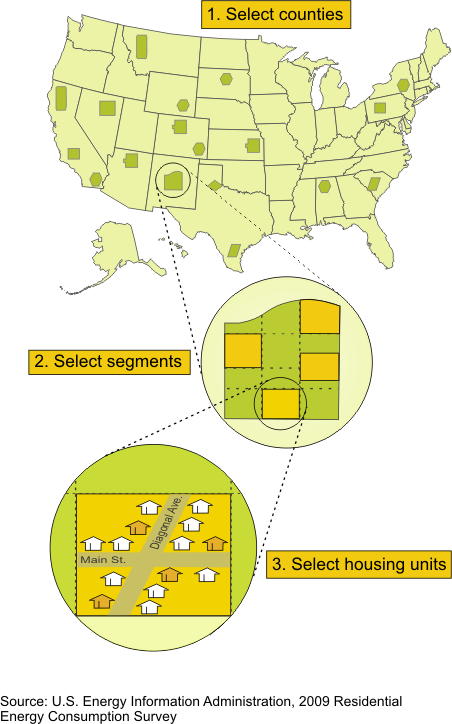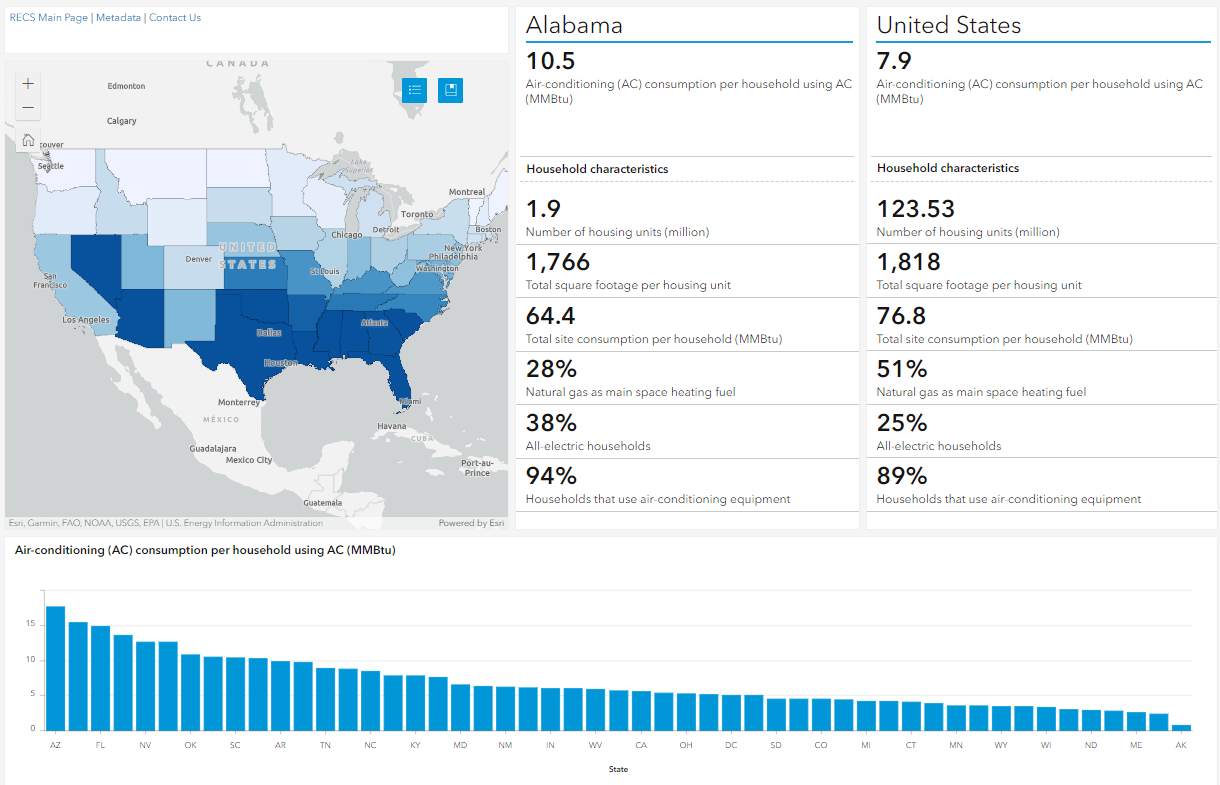How does EIA estimate energy consumption and end uses in U.S. homes?
RECS 2009 — Release date: March 28, 2011
EIA administers the Residential Energy Consumption Survey (RECS) to a nationally representative sample of housing units. Specially trained interviewers collect energy characteristics on the housing unit, usage patterns, and household demographics. This information is combined with data from energy suppliers to these homes to estimate energy costs and usage for heating, cooling, appliances and other end uses – information critical to meeting future energy demand and improving efficiency and building design.
RECS uses a multi-stage area probability design to select sample

A multi-stage area probability design ensures the selection
of a representative sample ofhousing units in the United
States.
All housing units in the 50 States and the District of Columbia that are occupied as primary residences are eligible to be included in the RECS sample.
Sample selection begins by randomly choosing counties. The selected counties are then sub-divided into groups of Census blocks called segments and a sample of segments is randomly drawn from the selected counties. Within each selected segment, a list of housing units (sample frame) is created by field listing.1
The final sample of housing units is randomly selected from the housing unit frame constructed from the selected area segments. This type of sampling is called a multi-stage area probability design. Its proper application ensures that the selected sample represents the entire population of occupied housing units in the United States.
The number of counties, segments, and housing units to be selected are carefully controlled so that RECS produces estimates of average energy consumption at specified levels of precision within the following geographic levels, called domains: National, Census Region, Census Division, and individual states or group of states within Census Divisions.
Two surveys capture energy characteristics for sampled housing units: the Household Survey and the Rental Agent Survey
In the Household Survey, trained interviewers use a standardized questionnaire to collect data from the selected housing units. The field interviewer uses a laptop to record the householder's responses to the survey. This method of collecting data is called Computer-Assisted Personal Interview (CAPI).
Questions in the Household Survey are designed to collect energy-related characteristics of the housing unit ("What is the main fuel used for heating your home?"), as well as energy usage patterns of the household members ("How often is your dishwasher used?").
Where respondents in rental housing units are less sure of their housing unit's energy characteristics, EIA uses the Rental Agent Survey. Those data are collected by phone or in person from the unit's landlord or his/her representative.
All of the data collected from the Household and Rental Agent Surveys go through a series of rigorous statistical processes to ensure the highest possible data quality. These processes include:
- editing
- validation and quality control
- imputation of missing data
EIA collects consumption and expenditure data from energy companies through the Energy Supplier Survey
After the Household and Rental Agent Surveys are completed, EIA conducts the Energy Supplier Survey (ESS). ESS is a follow-on mail survey2 required of energy companies that serviced housing units in the Household Survey. ESS gathers data on how much electricity, natural gas, fuel oil, and propane were consumed by the sampled households during the reference year. ESS also asks for actual dollar amounts spent on these energy sources. Data from the ESS follow the same quality assurance procedures as those from the Household and Rental Agent Surveys.
Did You Know?
According to the American Community Survey, in 2009 there are about 113.6 million occupied housing units in the United States. About 19,000 were selected for RECS interviews but only about 15,300 were occupied primary residences and eligible for RECS. Of these, about 12,100 responded to the survey, a response rate of about 79%.
EIA produces estimates of end uses of energy by modeling the data from the Household and Energy Supplier Surveys
The flagship product of RECS is the estimate of how much energy is used within the home for heating, cooling, refrigeration, and other end uses. EIA uses RECS to estimate end-use consumption through a non-linear statistical model applied to data from the Household and Energy Supplier Surveys, which disaggregates total energy consumption into end-use components.
These estimates of energy end uses make RECS uniquely important: it is the only survey that provides reliable, accurate and precise trend comparisons of energy consumption between households, housing types, and areas of the country.
Learn More
1 For the first time in its 30-year history, residential addresses from the U.S. Postal Service were used to construct a substantial portion of the 2009 RECS housing unit frame. 2 The use of the internet as a primary data collection method for ESS was initiated in the 2009 RECS.

 View the dashboard ›
View the dashboard ›